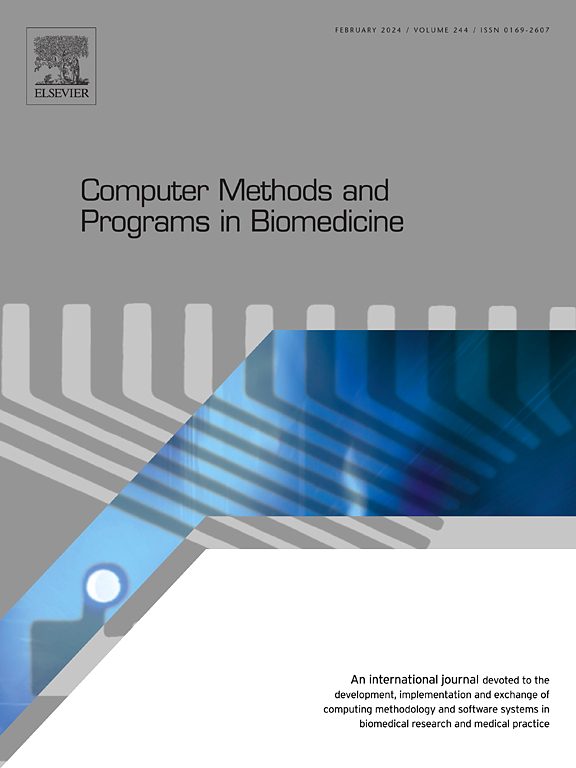HybridDLDR: A hybrid deep learning-based drug resistance prediction system of Glioblastoma (GBM) using molecular descriptors and gene expression data
IF 4.8
2区 医学
Q1 COMPUTER SCIENCE, INTERDISCIPLINARY APPLICATIONS
引用次数: 0
Abstract
Background and Objective:
Glioblastoma (GBM), a very aggressive type of brain tumor, sometimes creates a chemoresistant state that compromises the effectiveness of chemotherapy and leads to serious clinical complications in treatment. Predicting drug resistance is crucial for the improvement of medication effect during cancer treatment. Assessing drug resistance is difficult due to the pricey chemotherapeutic trails and prolonged laboratory investigations. Deep learning plays a significant role in drug resistance prediction nowadays.
Methods:
This paper presents a novel deep learning model that combines Convolutional Neural Networks (CNN), Long Short Term Memory Networks (LSTM), and transformer architectures to predict drug resistance. The proposed application acts as a system that estimate the resistance of drugs based on gene expression details and chemical properties.
Results:
As compared with existing model for drug resistance prediction, proposed model achieved lower Mean Squared Error (MSE) of 0.4109 and Mean Absolute Error (MAE) of 0.5040, along with higher of 0.9635 and pearson correlation of 0.9999.
Conclusions:
This work significantly advances the fields of pharmacogenomics and personalized medicine through an in-depth evaluation that includes complex performance metrics and visualizations.
HybridDLDR:基于分子描述符和基因表达数据的胶质母细胞瘤(GBM)混合深度学习耐药预测系统
背景与目的:胶质母细胞瘤(GBM)是一种侵袭性很强的脑肿瘤,有时会产生化疗耐药状态,从而影响化疗的有效性,并导致严重的临床并发症。预测肿瘤耐药是提高肿瘤治疗效果的关键。由于昂贵的化疗试验和长时间的实验室研究,评估耐药性是困难的。目前,深度学习在耐药性预测中发挥着重要作用。方法:本文提出了一种新的深度学习模型,该模型结合了卷积神经网络(CNN)、长短期记忆网络(LSTM)和变压器架构来预测耐药性。该应用程序作为一个基于基因表达细节和化学性质估计药物耐药性的系统。结果:与现有耐药预测模型相比,所建模型均方误差(MSE)为0.4109,平均绝对误差(MAE)为0.5040,R2为0.9635,pearson相关系数为0.9999。结论:这项工作通过包括复杂性能指标和可视化的深入评估,显著推进了药物基因组学和个性化医疗领域。
本文章由计算机程序翻译,如有差异,请以英文原文为准。
求助全文
约1分钟内获得全文
求助全文
来源期刊

Computer methods and programs in biomedicine
工程技术-工程:生物医学
CiteScore
12.30
自引率
6.60%
发文量
601
审稿时长
135 days
期刊介绍:
To encourage the development of formal computing methods, and their application in biomedical research and medical practice, by illustration of fundamental principles in biomedical informatics research; to stimulate basic research into application software design; to report the state of research of biomedical information processing projects; to report new computer methodologies applied in biomedical areas; the eventual distribution of demonstrable software to avoid duplication of effort; to provide a forum for discussion and improvement of existing software; to optimize contact between national organizations and regional user groups by promoting an international exchange of information on formal methods, standards and software in biomedicine.
Computer Methods and Programs in Biomedicine covers computing methodology and software systems derived from computing science for implementation in all aspects of biomedical research and medical practice. It is designed to serve: biochemists; biologists; geneticists; immunologists; neuroscientists; pharmacologists; toxicologists; clinicians; epidemiologists; psychiatrists; psychologists; cardiologists; chemists; (radio)physicists; computer scientists; programmers and systems analysts; biomedical, clinical, electrical and other engineers; teachers of medical informatics and users of educational software.
 求助内容:
求助内容: 应助结果提醒方式:
应助结果提醒方式:


